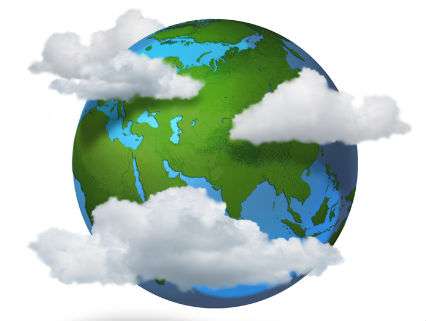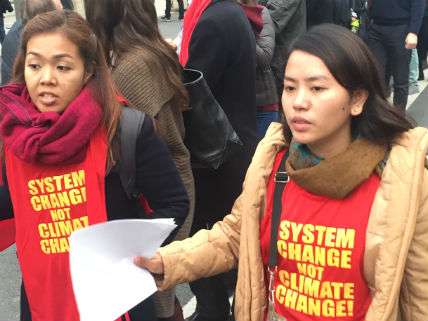Earth Day 2016: Paris Climate Agreement Signed
Too weak or a giant bureaucratic threat to democracy?

This Earth Day, representatives of some 170 countries gathered at the General Assembly of the United Nations in New York to sign the Paris Agreement on Climate Change. The document, which was hammered out at the U.N.'s 21st climate change conference in Paris in December of last year, commits signatories to work toward limiting the rise of global temperatures to less than 2 degrees Celsius above their pre-industrial average, and to strive to keep the increase below 1.5 degrees Celsius by 2100.
All 196 parties to the United Nations Framework Convention on Climate Change (UNFCCC), an international treaty dating back to the early 1990s, have adopted the Paris Agreement.
But climate activists wasted no time complaining that it's is too weak. "There is still a dangerous gap between what the governments are signing up to, what they are doing and the real ambition we need to avert the worst impacts of climate change," said May Boeve. executive director of the climate justice group 350.org, in a statement. "As a movement we will continue to hold governments accountable, ensure they ratify the treaty, go well beyond their current targets and accelerate the transition to 100% renewable energy." Climate Justice and Energy Coordinator at Friends of the Earth International Sarah Shaw denounced the signing ceremony as "the global elite's theatre" and declared the agreement "irresponsibly insufficient." Shaw added, "We cannot count on such an agreement alone to achieve climate justice."
The United Nations artfully explains that the Paris Agreement is "a legal instrument that will guide the process for universally acting on climate change. It is a hybrid of legally binding and nonbinding provisions." The core is a set of administrative and procedural requirements. For example, signatories must commit to reporting on their progress at regular intervals. However, concrete goals, such as reduction targets for greenhouse gas emissions or amounts of foreign "climate aid" a country will provide, are voluntary. Leaders are authorized to set their own "nationally determined contributions" in those areas, which are then registered at the U.N.
In our nationally determined contribution, the Obama administration promises that the U.S. will reduce its greenhouse gas emissions by 17 percent below 2005 levels by 2020, and by 26 to 28 percent by 2025. These reductions will supposedly be achieved by implementing domestic regulations, including tightening automobile fuel economy standards and cutting carbon dioxide emissions from electric power generation by 30 percent under the Environmental Protection Agency's legally-challenged Clean Power Plan.
Constitutionally, two-thirds of the U.S. Senate has to give its advice and consent before the U.S. can formally enter into a treaty. However, the Obama administration argues that the Paris Agreement is really an "executive agreement" that doesn't require signoff from the upper chamber—which is convenient since the Republican-controlled body is not particularly eager to give the White House what it wants.
The State Department's Foreign Affairs Manual explains that presidents may conclude executive agreements in three cases: pursuant to a treaty already authorized by the Senate; on the basis of existing legislation; and pursuant to his authority as Chief Executive when such an agreement is not inconsistent with legislation enacted by the Congress.
In arguing for treating the Paris Agreement as an executive agreement, the Obama administration points out that the U.S. Senate approved the UNFCCC back in 1992, and that that framework established the procedures under which international climate negotiations continue to operate. In addition, the U.S. is already obliged under the UNFCCC to collect and report its greenhouse gas emissions data. So the Paris Agreement's reporting requirements are merely an extension of those in the previously ratified treaty, Obama says. Since the Paris Agreement ostensibly does not impose any additional obligations beyond those that already exist pursuant to domestic laws, he contends that he has the authority to conclude an executive agreement that commits the U.S. to abide by it.
According to its terms, the Paris Agreement will enter into force 30 days after at least 55 countries, accounting for 55 percent of global greenhouse gas emissions, deposit their instruments of ratification or acceptance with the Secretary-General of the United Nations. More than 150 countries are signing it today, meaning the agreement could take effect as early as June.
Stated otherwise, the Obama administration is committing the U.S. to honor promises that may well go into effect before the election of the next president. Once that happens and the agreement is in force, a party can begin the process of withdrawing only after three years—and then it must wait an additional year after filing its official withdrawal notification. Republicans are understandably concerned that, even if their party takes back the White House in November, the next president's hands may be tied through 2020.
But there's a more significant problem with how the Paris Agreement is structured. The goal is supposedly to keep future global temperatures from rising less than 2 degrees Celsius, but in a March 2016 review, two Italian climate change researchers associated with the University of Venice reported that the current nationally determined contributions will come up short—way short. Adding them up, the researchers found that the global trajectory of greenhouse emissions will still rise from 44 gigatons annually now to almost 57 gigatons by 2030. To keep on track to limit future increases to less than 2 degrees Celsius, the world would need to be emitting only 40 gigatons of greenhouse gases by 2030. If these calculations are correct, total emissions must not increase, but instead be reduced below their current levels.
The Energy and Climate Intelligence Unit calculates that if global greenhouse gas emissions peak as late as 2030, future emissions would need to be cut annually at a rate of 9.6 percent in order to stay below the 2 degree Celsius threshold. This is only possible via in negative emissions of 4.1 gigatons annually. Negative emissions are achieved by massively implementing Bio-Energy with Carbon Capture and Storage (BECCS), a process that involves growing plants, burning them, capturing the carbon dioxide that's released, and pumping it underground.
The Italian researchers also compared the promises made by big emitters in their nationally determined contributions. After setting all countries to a 2005 emissions baseline, they report that emissions from Brazil, Canada, the European Union, Japan, Russia, and the U.S. will be cut in 2030 by 43 percent, 30 percent, 37 percent, 26 percent, 3 percent, and 26 percent, respectively. However, tracking the economic growth projections outlined by the International Energy Agency (IEA), emissions from China, India, Indonesia, and Mexico will rise by 150 percent, 253 percent, 226 percent, and 32 percent respectively. What does that mean in practice? Developing countries could wellincrease their emissions faster than the developed world can cut theirs.
The International Energy Agency estimated in its 2015 Energy and Climate Change report that in order to have a 50 percent chance of staying below 2 degrees Celsius, the world can emit a total of 3,000 gigatons of carbon dioxide. Humanity has already emitted around 2,000 gigatons, which leaves a carbon dioxide budget of 1,000 gigatons.
How should the remaining 1,000 gigatons be divvied up? The Italian researchers cite a 2015 study from the French Economic Observatory that suggests that, under a system of "climate fairness," India, Indonesia, China, Brazil and Mexico should be permitted to emit 50 gigatons each between now and 2040. On the other hand, the U.S. and Canada are carbon dioxide "debtors" that should be allowed to emit nothing at all and in fact should be expected to soak up 26 and 19 gigatons respectively by 2040.
Needless to say, there's a yawning mismatch between the ambitious goal of keeping temperatures from rising beyond 2 degrees Celsius and the promises made in the current nationally determined contributions.
"In reality, the Paris Agreement is a compilation of nationally determined intended contradictions," declared Vienna University socio-economist Clive Spash. He points out that the agreement does not mention fossil fuels at all and actually offers no plan or roadmap for achieving its emissions targets. In addition, it has no enforcement mechanism, and countries may withdraw from it without suffering any sanctions.
Interestingly, Spash proposes a simple test for the agreement's effectiveness: Did the share prices of fossil fuel companies drop after its adoption? As it happens, the Dow Jones coal index fell from 481 points in 2011 to just 12 points in January (a drop of 97.5 percent), although it has bounced all the way back up to 34 points today. The S&P's global oil index peaked in 2014 at 2,560 points, dropping by mid-January to 1,240 points (down 52 percent). But it too is up to 1,600 points now. Whether the Paris Agreement had anything to do these trends or not, the shares of hydrocarbon companies have not been well-loved by investors of late.
Meanwhile, Lucas Bergkamp, the head of European Regulatory Practice at the international law firm Hunton and Williams, sees the Paris Agreement as a "Trojan Horse" that poses a grave threat to constitutional government. Along with his colleague Scott Stone, Bergkamp argues that the gap between the agreement's ambitious goals and the admittedly insufficient national climate plans leaves space for UNFCCC bureaucrats, climate activists, and unaccountable judges to engage in policy laundering. This occurs when activists (and their allied bureaucrats and politicians) use treaties or other international agreements to justify imposing rules, regulations, taxes, and mandates that lack domestic political support. The rationale amounts to "The treaty (or agreement) made me do it."

For example, climate activists masquerading as the representatives of "civil society" might assert that international obligations under the Paris Agreement require courts to step in and order governments to perform their legal duty to protect citizens from climate change. In fact, last year a Dutch court ordered the government of the Netherlands to do exactly that by reducing the country's greenhouse emissions by 25 percent below 1990 levels by 2020. Unless governments are careful, Bergkamp warns that the Paris Agreement could morph into a vast bureaucratic monstrosity beholden only to climate activists and crony capitalists.
Bergkamp cites political theorist Isaiah Berlin's definition of a totalitarian society as "one that places one goal so far above the others that anything can be sacrificed in its pursuit." That should sound familiar: Protesters at climate demonstrations regularly feature banners with the slogan:"System change, not climate change." In her recent book, This Changes Everything: Capitalism vs. the Climate, activist Naomi Klein does not put too fine a point on it when she declares that the climate change issue has given progressives "the most powerful argument against unfettered capitalism" ever.
So who is right: Spash, who says the agreement doesn't go far enough to achieve its goal, or Bergkamp, who thinks it will enable activists to impose laws on unwilling populations? As someone who's been reporting on United Nations climate negotiations since the 1992 Earth Summit in Rio de Janeiro where the UNFCCC was adopted, I've seen both the climate justice movement and the U.N. and domestic climate bureaucracies massively expand and gain influence. Global warming is a problem, but I fear that Bergkamp has a point.


Show Comments (215)